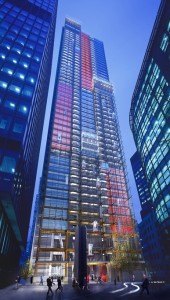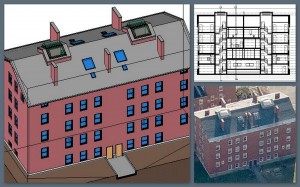CAD Rendering in the Cloud : Project Neon
Posted by Jim Foster in CAD, cloud on July 26, 2010
In short order Autodesk Labs is releasing a flurry of projects, and it is stuff that people want to use unlike a sub menu command in Revit 2012 that 12 people rejoice over, this is stuff that people want to use in their day to day. I understand that there have been server farms out there that can be used for rendering and it makes absolute sense. I also understand that there was storage on remote servers and file sync programs for a long time but until jungledisk and dropbox come along to put a pretty bow around it and make it more intuitive the percentage of the population who is going to use it would remain small, better software, better interface, bigger pie, exponentially bigger pie.
Project Neon allows for the export of dwg into the cloud viw the Neon interface, set parameters, and let it go to work. Not ever having to watch a painful block by block rendering, much like an 96 year old man shoveling a 200 yard driveway is worth the price of admission alone, which did I tell you, is free.
BIM Malaysia is on Board : BIM Adoption increasing
Posted by Jim Foster in Adoption, BIM on July 26, 2010
 Like the GSA, the State of Wisconsin, the State of Texas, now the country of Malaysia is on the board according to to this recent article in the Malay Mail.
Like the GSA, the State of Wisconsin, the State of Texas, now the country of Malaysia is on the board according to to this recent article in the Malay Mail.
Public Works Department (PWD) director-general Datuk Seri Dr Judin Abdul Karim said the department, in supporting the government’s desire to maximise the value of investment throughout the development plans, would utilise and enforced various ICT solutions in its strategies. This includes to spearhead the adoption and usage at all levels of Building Information Modeling (BIM) software and applications in building design.
The theme of this brief article seemed to be get on board or get left behind. “Geez Jim would you get off this BIM bandwagon,” I hear some of you saying, although I doubt you’re reading this if you are not right behind me playing the tuba, “you’re worse than the ice cream truck at little league games.” However I call them like a I see them, and I do understand the legacy tail of 2D and traditional CAD is long and will be with us for a very long time, not only that, I believe there will be a large market for hybrid technologies and also ones making CAD better but no one ever argued the development of the jet engine and its almost complete adoption in the aviation industry, except for maybe those companies just making propellers.
Using BIM for Sustainable Design
Posted by Jim Foster in BIM, Sustainable Retrofits on July 26, 2010
 Good article in Architecture Week titled, strangely enough, Using BIM for Sustainable Design, I guess we’re getting that horse out of the stable again, but this is it. Like AARA funds and the stimulus package put every paver and asphalt layer in the US back to work, sustainable design and retrofits are and will be it. Eddy Kryiegel, the author, goes on to elaborate the ease that option analysis and energy modeling that comes with BIM.
Good article in Architecture Week titled, strangely enough, Using BIM for Sustainable Design, I guess we’re getting that horse out of the stable again, but this is it. Like AARA funds and the stimulus package put every paver and asphalt layer in the US back to work, sustainable design and retrofits are and will be it. Eddy Kryiegel, the author, goes on to elaborate the ease that option analysis and energy modeling that comes with BIM.
In the case of energy modeling and its relationship to BIM, there are three primary steps involved: modeling the building geometry, adding building loads, and performing the analysis.
If you compare the time it takes to perform each of these steps for the same building type across a variety of analysis packages, you will see very similar results. During years of integrated practice, I have found that more than 50 percent of the overall time needed to perform an energy analysis is consumed by modeling building geometry.
Adding building loads accounts for about 35 percent, followed by less than 15 percent to perform the actual analysis. By simply being able to reuse the model geometry and transfer the building design from the BIM model to the energy model, we can reduce the time needed to run an energy model by almost half.
The traditional process of energy modeling within our own office typically takes a couple weeks. Using the workflow established with BIM, we can now perform some types of energy analysis in half the time, do twice as many as before, or make energy analysis available to projects that would normally not have the fee to support the endeavor.
A) If a project is started in BIM more services can be offered whereas they were too expensive the traditional way, and B) with option analysis you can find ways to make your building more efficient, demonstrate that with positive ROIs and have the analysis and design pay for itself. Just keeps on getting more compelling, like the Lebron laugh-a-lympics televised special, no strike that, like Lindsey..strike that, like having your cake and eating it too.
Photofly : Real 3D from Photos : Cloud Computing Magic : #bim #cloud
Posted by Jim Foster in Autodesk, BIM, Existing Conditions, Laser Scanning, New Technologies on July 24, 2010
 While I have not taken this for a test drive yet the videos and technology behind this are impressive and could provide a very valuable tool set. First, a word about technology. Too many times software presupposes too much knowledge or interest on the user, that is this software can do some amazing stuff you just have to sit down with it, go through the manual, try and use it, sit in a classroom, hit the user groups, etc. to master it and make it a useful and successfully incorporate into your workflow. If you are like me you might be open minded to that but the benefits of learning a brand new software package have to be pretty amazing to entertain that process. Enter Photofly. From what I have pulled up and I included two videos here you upload standard digital photographs, which could range from your iphone to your 18 Megapixel Digital SLR, and Photofly does its magic in the cloud utilizing its own servers to render a photographic 3D image, that can be scaled using a known dimension to a dimensionally correct model that can also be exported to AutoCAD as a pointcloud. What?!$% From my perspective this is invaluable, and brings to the forefront technology that was only available from laser scanners. I am not saying this takes their place but any time you can put another arrow in your quiver for building surveying and documentation, the better. And if this is as intuitive as these 2 videos make it out to be, this is a home run.
While I have not taken this for a test drive yet the videos and technology behind this are impressive and could provide a very valuable tool set. First, a word about technology. Too many times software presupposes too much knowledge or interest on the user, that is this software can do some amazing stuff you just have to sit down with it, go through the manual, try and use it, sit in a classroom, hit the user groups, etc. to master it and make it a useful and successfully incorporate into your workflow. If you are like me you might be open minded to that but the benefits of learning a brand new software package have to be pretty amazing to entertain that process. Enter Photofly. From what I have pulled up and I included two videos here you upload standard digital photographs, which could range from your iphone to your 18 Megapixel Digital SLR, and Photofly does its magic in the cloud utilizing its own servers to render a photographic 3D image, that can be scaled using a known dimension to a dimensionally correct model that can also be exported to AutoCAD as a pointcloud. What?!$% From my perspective this is invaluable, and brings to the forefront technology that was only available from laser scanners. I am not saying this takes their place but any time you can put another arrow in your quiver for building surveying and documentation, the better. And if this is as intuitive as these 2 videos make it out to be, this is a home run.
Photofly Intro Video
Wrigley Field Gets Modeled From Tourist Photos
Project Butterfly : Autodesk continues with SaaS : #BIM #CAD #saas
Posted by Jim Foster in CAD, cloud, New Technologies, SaaS on July 22, 2010
Autodesk continues to move forward with their Saas (software as a service) offerings. While Project Twitch allowed users to test drive a variety of software without saving or uploading anything Project Butterfly give you space in the cloud to upload your files and drive through them, collaborate, save all within a web base AutoCAD environment. I have just started playing around with it, although it has been out for awhile and although there is a bit of lag but it still delivers. I believe getting files, models, etc. in the cloud is the beginning. The start of real collaboration, the start of value added services, the start of a more efficient work place and the market leader is starting to figure it out.
Design Build Boom : AECOM acquires Tishman : #BIM
Posted by Jim Foster in BIM, economic trends, Virtual Construction on July 16, 2010
 I have suggested among others that the optimum work flow could be architects focus on the design, not construction docs or the BIM, but the design and then consult during the actual engineering and BIM process, that way it minimizes redundant efforts especially in regards to BIM creation. This process also would suggest the rise of design/build firms. AECOM just took a huge bite out of that apple when terms were disclosed yesterday that they agreed to acquire Tishman for $245 Million Dollars creating a design/build behemoth. Strategically, vertical integration is a double edged sword. Positively, you have control of costs and quality and capture every last dime a developer was intending to put into the project. Negatively, you have to feed the beast and can you really be that good at all disciplines?
I have suggested among others that the optimum work flow could be architects focus on the design, not construction docs or the BIM, but the design and then consult during the actual engineering and BIM process, that way it minimizes redundant efforts especially in regards to BIM creation. This process also would suggest the rise of design/build firms. AECOM just took a huge bite out of that apple when terms were disclosed yesterday that they agreed to acquire Tishman for $245 Million Dollars creating a design/build behemoth. Strategically, vertical integration is a double edged sword. Positively, you have control of costs and quality and capture every last dime a developer was intending to put into the project. Negatively, you have to feed the beast and can you really be that good at all disciplines?
On a side note, I was speaking to an integration specialist at Bentley who told me AECOM was a Microstation shop. This may be because back in the day the US Government was using a lot of Microstation and AECOM gets the majority of their work from the public sector. Tishman, and I am only speculating here, was most likely Revit. Skidmore, Owings & Merrill LLP (SOM) used Revit at World Trade and Tishman was on as construction. Quick google search shows they still seem to use it on current projects. Future projects and technology they use could be a proxy for the industry.
CALGreen is Coming : More Markets for Energy Analysis : Green Building : #BIM
Posted by Jim Foster in BIM, Green, Sustainable Retrofits on July 13, 2010
 Signed in 2004, mandatory in 2011 Executive Order S-20-04 set in motion a whole new set of building codes to reduce energy purchases by 20% by 2015. I included section 1 and 2 in their entirety below.
Signed in 2004, mandatory in 2011 Executive Order S-20-04 set in motion a whole new set of building codes to reduce energy purchases by 20% by 2015. I included section 1 and 2 in their entirety below.
1. That the state commit to aggressive action to reduce state building electricity usage by retrofitting, building and operating the most energy and resource efficient buildings by taking all cost-effective measures described in the Green Building Action Plan for facilities owned, funded or leased by the state and to encourage cities, counties and schools to do the same.
2. That state agencies, departments, and other entities under the direct executive authority of the Governor cooperate in taking measures to reduce grid-based energy purchases for state-owned buildings by 20% by 2015, through cost-effective efficiency measures and distributed generation technologies; these measures should include but not be limited to: 2.1. Designing, constructing and operating all new and renovated state-owned facilities paid for with state funds as “LEED Silver” or higher certified buildings; and 2.2. Identifying the most appropriate financing and project delivery mechanisms to achieve these goals; and 2.3. Seeking out office space leases in buildings with a U.S. EPA Energy Star rating; and 2.4. Purchasing or operating Energy Star electrical equipment whenever cost-effective.
Not only that, within the Executive Order their is a provision for CALPERS (the California Pension plan and huge investor) are ‘requested to target resource efficient buildings for real estate investments and commit clean technology funds to advanced sustainable and efficiency technologies.’
You can jump the new building codes home page here. With the GSA requiring a BIM on all new building and major renovations and now California requiring Green Building Practices in all their public buildings the increase in new technologies related to building will continue to grow. To completely beat the dead horse into submission, not that a dead horse needs to be beat any more, metaphorically speaking, but…sustainable retrofits, say it again…
The Building IS the operating system : BIM – SketchUp – Revit Free?
Posted by Jim Foster in Autodesk, BIM, Open Standard on July 8, 2010
 If you free it, they will come. Hasn’t that been proven many times over in the software world? Not always the most viable business model, but sure to gain traction and then we can figure out the revenue streams, or the revenue streams will figure themselves out as we get volume. If the majority of what you do on the web is surfing and e-mailing, the software you use is free. If you are composing spreadsheets and documents using google docs and/or Open Office it is free. It’s really the value you imbue these documents with that have value and people are starting pay for. Your the NYTimes and your content is important to people, you sell ads. Your facebook, well it will be ads again, or maybe facebook gets a cut from all the digital nothingness people buy in the form of cyber poker chips and farm tools from Zynga but I’m getting off point.
If you free it, they will come. Hasn’t that been proven many times over in the software world? Not always the most viable business model, but sure to gain traction and then we can figure out the revenue streams, or the revenue streams will figure themselves out as we get volume. If the majority of what you do on the web is surfing and e-mailing, the software you use is free. If you are composing spreadsheets and documents using google docs and/or Open Office it is free. It’s really the value you imbue these documents with that have value and people are starting pay for. Your the NYTimes and your content is important to people, you sell ads. Your facebook, well it will be ads again, or maybe facebook gets a cut from all the digital nothingness people buy in the form of cyber poker chips and farm tools from Zynga but I’m getting off point.
Think of the building, or the digital manifestation of the building as the operating system, the OS. Now I want to run an energy analysis on the building, heating and cooling loads, solar analysis, or I want to do a cost analysis on sustainable retrofits, or even new construction. It can all start with generic structure or masses, that is I have generic mass of blocks and objects, it’s when it has to be put into context that it needs to be defined. From this is a wall, and this is a window, to this is a steel stud wall with 3/8″ gyp on each side, and this is a window with triple pane low-e glass, etc. It depends on what you need it for that it needs to be defined, energy analysis you want the R values, cost analysis for construction, types, and even then you may not want to populate that whole model with those defined types because it gets huge and you might not need it.
For all the different people who interface with the building the idea of a centralized model is an awesome thing, and it has been the idea of BIM that has brought this forward. However, think of having the BIM in the cloud, and now it becomes the OS and I want to build applications for it. Energy Analysis, Cost Analysis, Maintenance Contracts, Build Outs, etc. etc. it opens the building to the market. And if it can start as generic components and then people pick and choose what type of data and services they want to use to add value well it starts to sound like the iphone and the app store, or android and the app store, or facebook with Zynga, etc. that is free at first but customers willing to pay for the things that give them value. We can all argue the benefits of why having a BIM of your building allows you to manage what may be your biggest asset more efficiently and save money, energy, etc. however, combine those things with free, well that’s where SketchUp is bringing us, the free building OS, and we’re all going to be playing in the app store.
Revit As Built : Field BIM Technology : Build Digitally As You Measure : #BIM #Revit
Posted by Jim Foster in BIM, Laser BIM, New Technologies, Point to Point Laser Technology, Revit on July 2, 2010
It’s been a hau l and it starts with a quote from Irwin Jungreis one of the founders of Revit who I spoke to early in the process, ‘we never intended Revit to have an API,’ he said with a smile. ” It was supposed to be so good it would never need 3rd Party applications.” “WHAT?!” you say. I believe Irwin at the point understood the original hubris of that statement but then again I spoke to him after they sold out to Autodesk. “So what” we thought and we continued to forge ahead with an API that had as much horsepower as my old Puch moped. Thank you Autodesk for your continued efforts in beefing up the API but it has been a bear.
l and it starts with a quote from Irwin Jungreis one of the founders of Revit who I spoke to early in the process, ‘we never intended Revit to have an API,’ he said with a smile. ” It was supposed to be so good it would never need 3rd Party applications.” “WHAT?!” you say. I believe Irwin at the point understood the original hubris of that statement but then again I spoke to him after they sold out to Autodesk. “So what” we thought and we continued to forge ahead with an API that had as much horsepower as my old Puch moped. Thank you Autodesk for your continued efforts in beefing up the API but it has been a bear.
PointKnown is getting closer to releasing the commercial version of PKNail; it’s building surveying software. PKNail was programmed behind 7 years of building surveying experience. Our intention was to:
- Automate many of the rote tasks when creating existing conditions surveys of a building
- Create repeatable work flows
- Increase speed and accuracy by linking measurements directly into Revit
We understand surveying can be the bane of some people’s existence and it is a necessary evil to almost all projects, that is having accurate information to start the project. While we never considered it a bane or evil but when we would put on lunch and learns and dog and pony shows we usually got one of two reactions. One, where have you been my whole life I hate surveying or two, will you sell us the software because we do all our own measuring. We get it. And building in real time, in the field makes thing easier and building inside a familiar platform, and one that you will be designing or working in anyway makes you more productive right out of the box. I look forward to your feedback, comments we’re here to work with you. And to summarize my last statement in the video, ‘We’re much better at designing surveying software than making videos,’ but even comments on our production and lack of directing talents are welcome. Thanks for reading. – jim
Revit As Built : Field BIM : Existing Conditions
Posted by Jim Foster in BIM, New Technologies, Revit, Uncategorized on June 29, 2010
While I don’t usually take the time to pump my own gas with this blog I wanted to share the complete reversal in our deliverables over the last year. It used to be, way back at the end of 2008 that we delivered most of our building surveys in 2D AutoCAD format, now we would build in 3D, normally in ADT but our clients wanted 2D AutoCAD. From a surveying perspective a 3D object oriented universe worked better for us because essentially all the views were coordinated, that is build it in the floorplan directly, it is represented in elevation correctly. Anyone who has keyed up a plan in 2D knows where I am coming from, which if you are here reading this, means you know what I am talking about. Now, however, the bulk of what we do is deliver as-builts in Revit. The GSA requiring BIM has a lot to do with it, I believe, and Autodesk being the biggest player in the US means Revit becomes the default. Whether you like that or not does not matter, that’s the reality.
 Recently we have performed as built surveys at Phillips Exeter and Emmanuel College and we were field testing our laser to BIM technology, PKNail. It was created to capture typical conditions quickly and accurately. If you wanted to capture the Capitol Dome, I would suggest laser scanning, for capturing most situations Point to Point Laser Scanning (PPLT) should work just fine. PKNail converts measurements directly into a Revit workstation-wirelessly, measure a wall that wall is entered into Revit, encounter a door, window, Fire Extinguisher Cabinet, sink, if you can measure it, it can be placed quickly and easily into the model.
Recently we have performed as built surveys at Phillips Exeter and Emmanuel College and we were field testing our laser to BIM technology, PKNail. It was created to capture typical conditions quickly and accurately. If you wanted to capture the Capitol Dome, I would suggest laser scanning, for capturing most situations Point to Point Laser Scanning (PPLT) should work just fine. PKNail converts measurements directly into a Revit workstation-wirelessly, measure a wall that wall is entered into Revit, encounter a door, window, Fire Extinguisher Cabinet, sink, if you can measure it, it can be placed quickly and easily into the model.
Lastly, if the deliverable is 2D CAD, exporting views from Revit to AutoCAD sheets is a snap. Here’s a long winded Autodesk treatise on the subject or well, it looks like I will need to update with a screen capture video the quick process but the resulting CAD contains some of the meta information collected in 3D, such as 30″ Door, rather than creating anonymous objects. Next post will follow in short order with a sneak peak of some of the features and the connectivity between Revit and a Leica Disto enabled by PointKnown surveying software.
Thanks for tolerating some self promotion.

